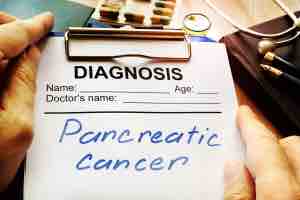
Watch this Article in Video Format
Julies story
A Personal Tragedy: Loss of My Mother
Pancreatic CA19 Tumours for cancer took my mother. I’m committed to making sure everyone knows about him.” A difficult-to-treat, growing tumour that too many people know little about. So Giulia decided to take action for research and awareness of cancer. «It is often said that when a patient receives a cancer diagnosis, the whole family becomes ill. It was like that for us.” At 23, Giulia lost her mother to pancreatic tumours, a blood test revealing disease that is still very complex to treat today, which does not give obvious symptoms until she is in an advanced stage and has one of the lowest survival rates. «We had never heard of it – says Giulia – until mother Filomena received the diagnosis in December 2016.
From one day to the next, she turned yellow. She had a tumour in the head of the pancreas, and we were told immediately that, unfortunately was not operable. In reality, she had had a few months of unspecific gastric disorders, digestive difficulties and reflux. The ultrasound showed an inflamed gallbladder that needed to be removed.
The Challenge of Symptoms and Diagnosis
Then, in the hospital, with the CT scan, they saw that it was something else.” THOSE ELUDE SYMPTOMS The symptoms of pancreatic cancer are variable, depending on the type of pathology. They rarely manifest themselves in the early stages of the disease and above all, they are quite common, experienced by many people for reasons that have nothing to do with a tumour. Among others, yellowing of the skin and eyes (due to tumours of the head of the pancreas), weight loss, abdominal pain, and oily stools; sometimes typical symptoms of initial diabetes appear, such as abnormal thirst, fatigue and frequent need to urinate. «With my sister and brother we looked for information, went around looking for the best specialists – continues Giulia -. But everyone could only confirm that there was no chance of recovery.
After a few cycles of treatment, my mother passed away in June. Just over six months had passed since the diagnosis. She was 58 years old.” In the photo, Filomena is together with Giulia’s father, who also passed away, “and this is the image that for me represents, even today, the unity of our family”. OMG, WHERE IS THE PANCREAS?” And today? «She has been gone for six years, but she is in my thoughts every day. I also think that today, it remains one of the most difficult tumours to diagnose in time and is little known. When it happened to us, some said, “Oh God, where is the pancreas?”.
Raising Awareness
Even today, when I talk about my story, there is often a bit of surprise, of disorientation. Many do not know what this disease is, that it is difficult to see, that the symptoms are subtle. They don’t know the factors that increase the risk and what we can do to reduce it. Many believe it is a super-rare tumour, but I hear of people getting sick instead. This is why I decided to act, to improve people’s awareness and to promote research. Too little is invested in research and prevention; we must do our part; it is in our interest. I opened a fundraiser in memory of my mother, for people currently affected by the disease and for those who will receive the diagnosis in the future so that research makes progress and there are more possibilities for a cure.”
The Impact Statistics and Challenges
Consult the Pancreatic Tumors Special BIG IMPACT, LITTLE KNOWLEDGE Although it is less common than other tumours (eighth among men and fifth among women in Europe), disease is the fourth leading cause of death in Europe (7.4% of all cancer deaths).
In Italy in 2022, 14,500 people fell ill. And in total, there are 21,200 men and women diagnosed with cancer. What matters is the often late discovery (less than a fifth of cases at diagnosis are operable with curative intent) and the treatments that are still ineffective. Survival rates have been at a virtual standstill for some time, and 11-12 out of 100 patients are alive five years after diagnosis.
The average age of diagnosis in Europe is 71 for men and 75 for women. Yet, most people say they are poorly informed, from symptoms to risk factors. RISK FACTORS In addition to age, there are modifiable factors that increase the likelihood of developing CA19 issues that need to be tested and eventually tumours. The first is cigarette smoking, then obesity, a sedentary lifestyle, high consumption of alcohol and saturated fats, red meat and processed foods, and low consumption of vegetables and fruit. These are behaviours that partially affect the risk of getting sick. Still, they have a crucial characteristic: experts estimate that correcting them can prevent up to a third of cases. Chronic pancreatitis, diabetes, or a previous gastrectomy also increase the risk.
Ongoing Research and Future Directions
Estimates suggest that in one case in ten, a family test history of ca19 may be due to specific heritable genetic conditions. These include Peutz-Jeghers syndrome, familial syndromes with multiple atypical nevi and melanoma, BRCA2 gene mutations, hereditary pancreatitis, and Lynch syndrome. Yet, research continues. Pancreatic CA19 Blood Test Scientists are studying new drugs both alone and in combination for tumour management. Significant improvements have emerged with the introduction of PARP inhibitors for patients with BRCA gene mutations, affecting between 4 and 7 percent of the total. We study the interactions between the tumour and the immune system to intervene in the factors that promote the disease. We work on predisposing factors to better identify people at risk and to be able to hypothesise surveillance programs to increase the possibility of early diagnosis.

